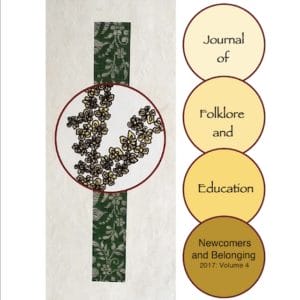By Paddy Bowman and Lisa Rathje
In Volume 4 of the Journal of Folklore and Education, Newcomers and Belonging, we highlight how educators in K-12, college, museum, and community settings are working positively and successfully with refugees and immigrants across the United States. Our aim has been to shine a light on what “belonging” means, not only on refugees and immigrants. Everyone has been and will be a newcomer throughout our lives, whether through a job change or moving in the middle of a school year, emigration or being expelled from a homeland. Everyone wants a sense of belonging, and at the same time “belonging” connotes a privilege that may often operate invisibly in our classrooms and communities.
By Jo Radner
By forging a path to reciprocity, the giving of a golden garland, a distinguished folklorist and storyteller worked with New Hampshire Humanities to tap Bhutanese refugees’ deep culture through a collaborative process that honors cultural contributions that newcomers can make in their new communities.
By Lucinda Megill Legendre, Janice Prevail, Kristin M. Larsen, Amy Brueck, and Linda Deafenbaugh
Teachers of English for second language learners are often the first to meet public education’s influx of refugee and immigrant students, and they employ creativity and innovation to help young people succeed.
By Nisha Arya and Daisy Ling
A first-generation immigrant found a home for her exploration of identity in the P.E. class of a teacher at Philadelphia’s Folk Arts-Cultural Treasures (FACTS) charter school.
By Amy Brueck
A Skype Club between students in Philadelphia and Indonesia reinforces American students’ home language and culture and teaches them important ethnographic skills.
By Amanda Dargan
A New York City series of programs focusing on immigrants’ gifts of arts and cultural expressions is an ongoing education project employing interviewing, classroom residencies, exhibits, and drama.
By Maureen K. Porter and Susan A. Dawkins
New immigrants’ strategic use of new media as explicit means of outreach and renewal directly counters a deficit discourse about diasporic communities and provides a rich resource for educators who wish to incorporate first-person accounts of resilience and intercultural dialogue into their teaching.
By Ruth Smith with Qorsho Hassan
A photonarrative project in Columbus, Ohio, has brought refugees, scholars, and artists into a long-term collaboration that shows how mentorship through storytelling can bring new ways of learning and knowing into educational environments.
By Kelly Armor
Bringing new Americans’ culturally diverse games and songs to early childhood classrooms has proven to be a treasure and a vital resource for the wider community.
By Lynne Williamson
Marrying refugee artists’ expertise in many forms of needlework with marketing, public programming, and ongoing collaboration has proven rewarding and successful.
By Christopher Mena with Elia Bojorquez
By advocating for careful listening to students’ knowledge of and passion for music from their lives, a music teacher demonstrates that K-12 school music programs are uniquely positioned to create productive learning spaces for refugee and immigrant students.
By John Sorensen
Inspired by the Nebraska social justice pioneer Grace Abbott, a leader in the struggle to improve life for children, immigrants, and women and Chief of the U.S. Children’s Bureau in the 1930s, the Quilted Conscience project has brought together refugees and quilters for ten years.
By Nicholas Hartmann
An ethnic museum in Iowa is engaged in a long-term initiative on intercultural collaboration, freedom, and human dignity through programs that highlight global experience while promoting local community engagement.
By Lilli Tichinin, Kathryn R. Taylor, Jeana Jorgensen, Trista Reis Porter, Lewis C. Seifert
Lloyd’s Treasure Chest: Folk Art in Focus, at the Museum of International Folk Art, Santa Fe, New Mexico, curated by Felicia Katz-Harris;
Teaching Tolerance http://www.tolerance.org;
Cinderella Across Cultures: New Directions and Interdisciplinary Perspectives edited by Martine Hennard Dutheil de la Rochère, Gillian Lathey, and Monika Woźniak;
Folklore Rules: A Fun, Quick, and Useful Introduction to the Field of Academic Folklore Studies by Lynne S. McNeill;
New Approaches to Teaching Folk and Fairy Tales edited by Christa C. Jones and Claudia Schwabe
 In Volume 4 of the Journal of Folklore and Education, Newcomers and Belonging, we highlight how educators in K-12, college, museum, and community settings are working positively and successfully with refugees and immigrants across the United States. Our aim has been to shine a light on what “belonging” means, not only on refugees and immigrants. Everyone has been and will be a newcomer throughout our lives, whether through a job change or moving in the middle of a school year, emigration or being expelled from a homeland. Everyone wants a sense of belonging, and at the same time “belonging” connotes a privilege that may often operate invisibly in our classrooms and communities.
In Volume 4 of the Journal of Folklore and Education, Newcomers and Belonging, we highlight how educators in K-12, college, museum, and community settings are working positively and successfully with refugees and immigrants across the United States. Our aim has been to shine a light on what “belonging” means, not only on refugees and immigrants. Everyone has been and will be a newcomer throughout our lives, whether through a job change or moving in the middle of a school year, emigration or being expelled from a homeland. Everyone wants a sense of belonging, and at the same time “belonging” connotes a privilege that may often operate invisibly in our classrooms and communities.
